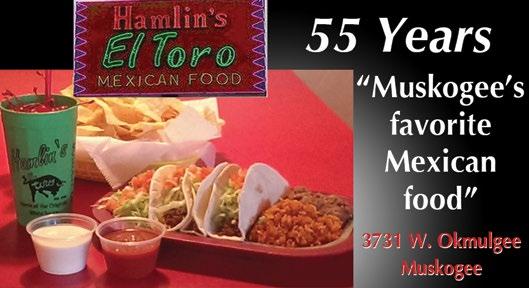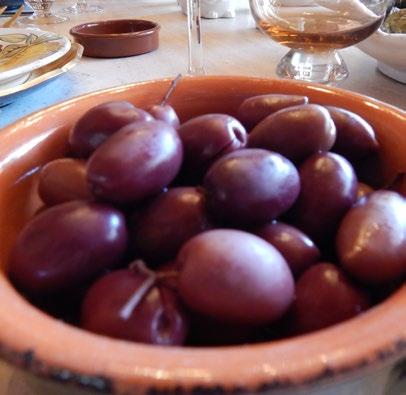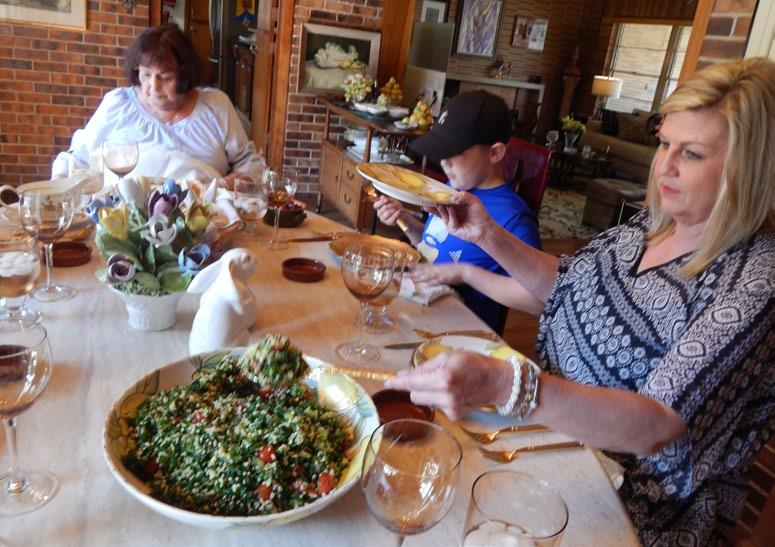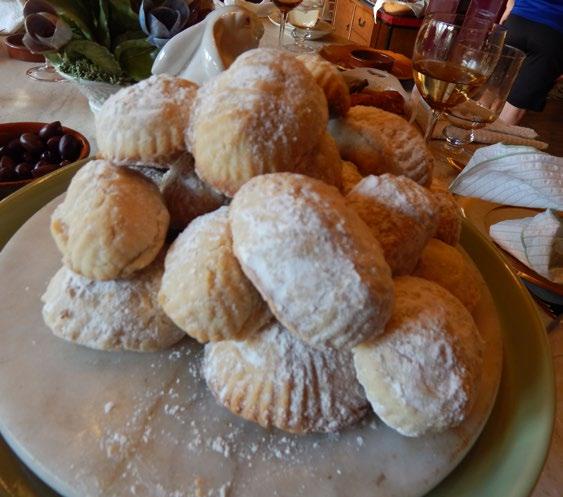
7 minute read
Cook’s Pantry
Family History At Home in
Lebanese heritage melds with modern world
Advertisement
Marcia Owen lives in family history. Her father, the late Muskogee architect Frederick Zaroor, designed and built the iconic home she lives in on Honor Heights Drive in 1952. In fact, her father’s architectural acumen can be seen across Muskogee in its many school buildings from Muskogee High School to Tony Goetz Elementary, Grant Foreman Elementary, Alice Robertson, and the former Manual Training High School, now Sadler
Arts Academy. It also extends to public structures such as the former OG&E building on Court Street and the former Sacred Heart Church on Broadway. In short, one could say that Zaroor built or remodeled much of modern Muskogee. The Cook’s Pantry
Melony Carey
Photos by Cathy Spauldin
Marcia’s grandfather, Anton Beshara, walked to Oklahoma from Missouri in 1904. He settled in Haskell where he built the first brick building that housed his successful mercantile store.
Marcia Owen spoons tabbouleh into a platter. Tabbouleh features bulgur wheat, parsley, green onion and tomatoes.

But architecture is not the only thing Owen inherited from her family. As the third generation of immigrants, Lebanese heri - tage and tradition resound in her cooking. Food played a major role in her family’s daily life as fruit merchants in Lebanon and con- tinued as they established them- selves in the United States.
“The name my father’s family took in America, Zaroor, is actu - ally the word for a fruit in Ara- bic,” Owen says. “At one time, one of my grandfathers had seven working farms and pro - vided produce to all the stores. It was a well-established family business.”
Traditional Lebanese reci- pes were carried down through the generations. Dishes such as tabbouleh, stuffed grape and cabbage leaves, hummus, and ma’moul tea cakes are family favorites.
“We don’t just eat to live,” Owen said. “We live to eat. That is our philosophy.” Rightly so, given the rich spices and flavors inherent in Middle Eastern cooking.
Owen learned the recipes by watching her mother and aunts in the kitchen where everything was made from scratch. On holidays they prepared and served SyrianLebanese dishes from memory. Without written recipes, Owen says the secret to recreating these beautiful dishes is “to grow up with it.” During her 35 years working for a geological survey in Dallas, she had access to spe- cialty stores that carried authentic Lebanese products, allowing her to develop her own expertise with the dishes.
Another aspect of the Leba- nese tradition Owen grew up with was the grace and beauty inherent in hospitality. Beirut, where much of her family was from, was considered the Paris of the Middle East. From her mother, Owen learned how to

LEFT: Karen Lauderdale, right, serves Lindsey Ketcham some white wine to complement the Middle Eastern food for a family feast.
set a beautiful table and appreciate the significance of social interactions and relationships. This is evident in her gregarious personality and generosity as a hostess. Her Lebanese cooking always attracts neighbors, and she is ever ready to open her house to friends.
Today, Owen considers her family to be steeped not only in Lebanese heritage, but also as among the influential settlers of Oklahoma. Her mother’s father, Anton Beshara, known as Papa Tony, came to America alone at the age of 16. He walked from Missouri to Oklahoma in 1904 to find better opportunity for his peddling business, a traditional form of vending in Lebanon and popular at the time across the American frontier. He was a well-respected trader in the Cherokee and Creek Nations, Indian Territory, and built the first brick building in the town of Haskell, housing a successful store. Papa Tony was also known as the “Garlic King,” having brought the cultivation of garlic to Northeastern Oklahoma. It is a proud story of survival, success and family legacy steeped in an abundance of love and good food.
Here Marcia and her sister, Karen Lauderdale, share recipes for recreating some of their favorite dishes.
Grape Leaf Ro s
1 quart jar grape leaves 1 pod garlic 2 lemons 2 cups rice, prepared 1/2 cup melted butter 2 teaspoons salt 1 teaspoon pepper 1 teaspoon cinnamon 2 lbs. cubed meat, such as sirloin
Prepare filling by mixing together rice, butter, salt, pep per, cinnamon, juice of one lemon, and meat (cubed small). Take one grape leaf and put in one teaspoon filling then rollup.

ABOVE: Cabbage rolls are best when filled with cubed sirloin.





ABOVE: What Middle Eastern supper is complete without olives?
Stack grape leaves in stew pan, placing garlic cloves in between layers. Pour water with the juice of one of the lemons to barely cover rolls. Put a small plate over the rolls to hold them down. Cook one hour or until done. Pour off remaining water.
Cabba e Ro s
2 heads cabbage 1 pod garlic 1 large bottle of tomato juice 2 cups rice, cooked 1/2 cup melted butter 2 teaspoons salt 1 teaspoon pepper 1 teaspoon cinnamon 2 cups cubed meat, sirloin preferred
Wrap cabbage in paper towel and cook in microwave for 15 minutes. Remove core of cabbage and separate leaves. Mix rice, butter, salt, pepper, cinnamon and meat (cubed small). Place mixture in cabbage leaf and roll. Place in large pan, adding garlic cloves throughout. Cover with tomato juice. Put a plate on top of rolls to hold in place. Boil 45 minutes uncovered. Cover and simmer 30 minutes more.
Tabbou eh
16 oz. bulgur wheat 2-4 bunches green onions 3-5 bunches parsley, cleaned and chopped without stems 2-4 tomatoes, seeds removed and chopped 1-1 1/2 cups fresh lemon juice


RIGHT: Tomatoes play an important role in
Mediterranean cuisine. FAR RIGHT: Rather than ground beef, Karen
Lauderdale’s recipe for stuffed grape leaves uses cubed sirloin.
A yogurt topping offers a soft touch to the Mediterranean meal.
Ma’moul tea cakes are a Lebanese delicacy. Orange blossom water is a key ingredient in creating an authentic cookie.


1-1 1/2 cups olive oil 4 teaspoons kosher salt 2 teaspoons pepper 1 tablespoon dried mint
The day before, wash parsley, spin dry, and cut with kitchen scissors. Put wheat into large bowl and add enough water to just cover. Let stand 30 minutes only. Squeeze out excess water in strainer. Add remaining ingredients and mix thoroughly. Taste for additional salt and pepper, and balance lemon juice and olive oil, if needed. Refrigerate overnight. Marcia says the use of bulgur and attention to trimming the parsley are key to delicious tabbouleh.
1 cup sugar 1 1/2 teaspoons baking powder 1/2 teaspoon salt 1/2 cup butter 1/2 cup shortening 1 egg slightly beaten 3 tablespoons cream 1 teaspoon vanilla 1 tablespoon orange blossom water
Sift flour with baking powder and salt. Add dry ingredients and butter. Mix well until dough feels like sand. Add remaining ingredients and form a ball of dough, smooth, but not sticky. Cover with plastic wrap and refrigerate overnight before making Ma’moul.
Ma’Mou Fi in :
walnut 1 tablespoon orange blossom water 1/4 cup sugar (optional) 1 tablespoon butter
Mix filling ingredients. Form dough into walnut-sized balls. From here you can use a Ma’moul mold or simply make an indentation with your finger, add the filling, and then roll the ball so that all the filling is covered. If using the mold, flour it before adding each cookie, then turn the pastry out by giving the mold a quick turn and tap. Keep dough chilled as working. Place the Ma’moul on a baking sheet lined with parchment paper and cook in a preheated 350 degree oven for 15-20 minutes. Pastries must remain very white. Sprinkle with powdered sugar as you take them out of the oven.








